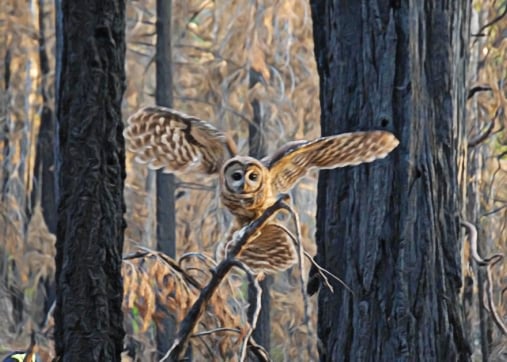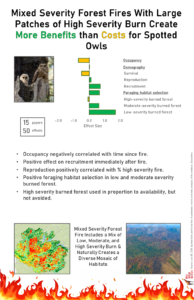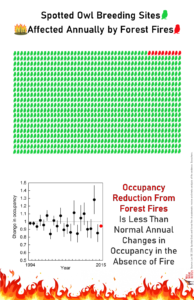Fifteen years of research about severely burned Snag Forests in the western U.S.A. and their important value as wildlife habitat and ecological services has produced a healthy body of scientific literature. These papers, and others, have opened the eyes of many to the now-obvious fact that burned forests create wildlife habitat and even old growth indicator species like spotted owls (Strix occidentalis) take advantage of this natural disturbance. Before these studies, forest managers and researchers commonly believed forest fire was an unnatural threat to the persistence of spotted owl populations, but this lengthy list of peer-reviewed scientific papers has busted that myth.
Monica Bond started this line of inquiry back in 2002 when she published Short-term effects of wildfires on spotted owl survival, site fidelity, mate fidelity, and reproductive success. Bond (and her co-authors R. J. Gutiérrez, Alan Franklin, Bill LaHaye, Chris May, and Mark Seamans) documented survival, site fidelity, mate fidelity, and reproductive success for 21 spotted owls after large wildfires occurred within 11 owl territories in California, Arizona, and New Mexico. In each territory, fire burned through the nest and primary roost sites. Survival was 0.86, similar to reported annual adult survival probabilities for the species in landscapes that had not experienced recent fire. No pair separations were observed after fire. Reproduction from burned territories was the same as from unburned territories. On the 8 territories where fire severities were mapped, 50% experienced predominantly low- to moderate-severity fires while 50% experienced high-severity fires that burned large (>30%) areas of the territories. This paper was the first look at forest fire and spotted owls and found that wildfires had no short-term impact on survival, site fidelity, mate fidelity, or reproductive success of spotted owls.
In Habitat use and selection by California spotted owls in a postfire landscape, the breeding-season foraging behavior of 7 owls from 4 territories was studied in a mixed-severity burned landscape for the first time. Mixed-severity results in a natural mix of low-, moderate- and high-severity burned vegetation with approximately equal proportions of each. Two nests were in areas of moderate-severity burn, one in an area of low-severity burn, and one nest was located in an unburned area. Within 1 km of the center of their foraging areas, spotted owls preferred foraging in all severities of burned forest and avoided unburned forest. Beyond 1.5 km, there were no differences in use patterns among burn severities. Owls preferentially foraged in high-severity burned forest.
This paper and the previous one should have killed the idea among forest managers that all fire has a negative impact on late-seral forest habitat specialists like spotted owls. Unfortunately, the false premise that moderate- and high-severity burned forest is not suitable spotted owl habitat continues to provide the rationale for timber harvesting as fuels treatments and post-fire salvage logging prescriptions called restoration. So our work continued…
In the early 2000s, a drought and pine beetle outbreak killed many trees in the mountains of southern California. This widespread tree mortality fueled another rumor about forest management, namely that dead trees cause more high-severity forest fire. In our paper, Influence of Pre-Fire Tree Mortality on Fire Severity in Conifer Forests of the San Bernardino Mountains, California, we examined how fire severity was affected by pre-fire tree mortality, vegetation characteristics, and topography. We found no evidence that pre-fire tree mortality influenced fire severity. Our results indicated that widespread removal of dead trees are not likely to be effective at reducing higher-severity fire in southern California’s conifer forests. We found that locations dominated by the largest size class of trees (≥61 cm diameter at breast height) burned at lower severities than locations dominated by trees 28-60 cm dbh. This result suggests that harvesting larger-sized trees during thinning for fire-severity reduction purposes is likely to be ineffective and possibly counter-productive.
In Winter movements by California spotted owls in a burned landscape, we followed 5 of our radio-marked owls from the habitat use and selection study over the nonbreeding season. Spotted owl populations are highly sensitive to reductions in adult survival, and mortality of adults is greatest in winter, yet the species’ needs for winter habitat are seldom considered in efforts at management. We found the owl increased their movements, expanded their territories, or migrated to a distinct winter season territory. During the nonbreeding season, three of five spotted owls roosted within the burned landscape to some degree. Spotted owls that roost in the burned landscape during the nonbreeding season may be continuing to forage in the burned areas throughout the fall and winter. Thus, burned forests represent used habitat for the California spotted owl during both the breeding and nonbreeding seasons.
In A New Forest Fire Paradigm: The Need for High-Severity Fires, Bond and co-authors Rodney Siegel, Richard Hutto, Victoria Saab, and Steve Shunk presented the viewpoint that mixed and high severity (collectively called ‘severe’) forest fires are both natural and necessary to maintain the integrity of dynamic, disturbance-adapted forest ecosystems. They proposed a change in the widespread paradigm—which holds that severe forest fires are always harmful—to a new one that embraces their ecological necessity.
In 2012, we analyzed 11 years of U.S. Forest Service breeding-season spotted owl monitoring data from 41 burned territories and 145 long-unburned territories throughout the Sierra Nevada in Dynamics of breeding-season site occupancy of the California spotted owl in burned forests. This is the largest before-after-control-impact study of how large, mixed-severity fires affect breeding site occupancy of spotted owls. We compared ‘territory extinction’ (the probability that a previously occupied territory was not occupied the following year), and ‘territory colonization’ (the probability that a previously unoccupied territory became occupied) at burned and unburned sites while accounting for annual and site-specific variation in detectability. The burned territories were within 6 large, mixed-severity fires ranging from 8,000 to 151,000 acres in extent. We found no significant effects of forest fire on extinction or colonization probabilities 1 to 7 years post fire, suggesting that fire, even so-called megafires that burned on average 32% (range = 1% to 93%) of suitable owl habitat at high severity within these California spotted owl territories, does not threaten the persistence of the subspecies on the landscape. In addition, 8 burned territories in our data were later salvage logged. Seven of the 8 sites were occupied by California spotted owls after the fire but none of the 8 sites were occupied after logging, strongly indicating salvage logging made the territories unsuitable for owls.
In Diet and home-range size of California spotted owls in a burned forest, we analyzed the prey species of spotted owls in a burned landscape for the first time. Home ranges were also analyzed because prey composition is an important determinant of raptors’ use of space, and owls with more biomass of larger prey in their diet generally have smaller home ranges. Prey consumed by owls in the burned area comprised 40.3% (by biomass) pocket gophers (Thomomys spp.) and 25.9% northern flying squirrels (Glaucomys sabrinus). In contrast, in long-unburned areas of the Sierra Nevada spotted owls fed primarily on flying squirrels, or on both flying squirrels and woodrats (Neotoma spp); in unburned southern California forests they fed overwhelmingly on woodrats. The owls’ mean home range in the burned forest was 402 ha, an area similar to that recorded in unburned forests of the Sierra Nevada. Our results are consistent with hypotheses that the burned owl habitat in our study area was rich in gophers and that spotted owls foraging primarily on gophers in burned forests do not require home ranges larger than owls in unburned forests.
Next, we published 2 papers analyzing 9 years of U.S. Forest Service survey data collected at 71 burned and 97 long-unburned breeding-season sites before and after fire, with 21 of the burned sites also post-fire salvage logged. This study took place in the mountains of southern California which are characterized by warmer, drier conditions and larger high-severity burns relative to the Sierra Nevada. This was the second largest before-after-control-impact study of how large, mixed-severity fires affect territory occupancy of spotted owls with 1 to 8 years of post-fire data. With this very large dataset, in Influence of fire and salvage logging on site occupancy of spotted owls in the San Bernardino and San Jacinto Mountains of Southern California, we found no statistically significant effects of fire on occupancy dynamics of spotted owls of southern California. However, there was some evidence that when territories burned almost entirely at high severity, sites had higher extinction rates. We then asked the question “what makes an owl territory resistant to disturbances?” In a follow-up paper, Previous year’s reproductive state affects spotted owl site occupancy and reproduction responses to natural and anthropogenic disturbances, we examined the relationship among owl territory occupancy, reproduction, high-severity wildland fire, and postfire logging more deeply using the same southern California data. This time, we discovered both occupancy and reproduction were positively correlated with successful reproduction in the previous year. Tree cover in a site’s 203-ha core area also was positively correlated with both occupancy and reproduction. We detected no effect of disturbance on reproduction, given that a site was occupied. Fire and postfire logging significantly reduced site occupancy in lower-quality sites that were nonreproductive the previous year (reduced 0.19 by fire and 0.26 by post-fire logging), but with negligible effect sizes in higher-quality sites that were occupied and reproductive the previous year (reduced 0.02 by fire and 0.03 by postfire logging). Thus, only marginal, nonreproductive sites showed adverse effects from disturbances. This study illustrated the important contribution of consistently occupied and productive breeding sites to populations of spotted owls, and demonstrated that both occupancy and reproduction at these higher-quality sites exhibited strong natural resistance to disturbances. Owl sites with recent reproduction and sites with more tree cover should receive enhanced protection from management actions that modify forest vegetation, and should definitely not be logged in the name of fuels reduction or postfire salvage logging.
In Alternative views of a restoration framework for federal forests in the pacific northwest, Bond and colleagues Dominick DellaSala, Robert Anthony, Erik Fernandez, Chris Frissell, Chad Hanson, and Randi Spivak presented a critique of the ‘ecological forestry’ strategy for federal forests in Oregon and Washington states. They identified how the so-called ‘ecological forestry’ strategy will likely create adverse consequences to natural resources, and offered suggestions and recommendations to improve the framework and its implementation.
In Effects of fire and commercial thinning on future habitat of the northern spotted owl, Dennis Odion, Chad Hanson, Dominick DellaSala, William Baker, and Monica Bond dismantle the arguments often made for thinning forests. Concerns over high-severity fire and reduced timber harvesting have led to programs to commercially thin publicly owned, federal forests, even within forests designated as “critical habitat” for threatened northern spotted owls. Thinning is only allowed under the U.S. Government spotted owl guidelines if the long-term benefits clearly outweigh adverse impacts. Adverse impacts from commercial thinning are caused by removal of key habitat elements and modification of forests to be more open than those likely to be occupied by spotted owls. Benefits of thinning may accrue through reduction in high-severity fire, yet whether the fire-reduction benefits accrue faster than the adverse impacts of reduced late-successional habitat from thinning was an untested hypothesis. This study found that rotations of severe fire (the time required for high-severity fire to burn an area once) in spotted owl habitat since 1996 were 362 and 913 years for the Klamath and dry Cascades. Using empirical data, the authors calculated the future amount of spotted owl habitat that may be maintained with these rates of high-severity fire and ongoing forest regrowth rates with and without commercial thinning. Over 40 years, habitat loss would be far greater due to thinning than it prevented from burning in high-severity fire. Thus, the requirement that the long-term benefits of commercial thinning clearly outweigh adverse impacts is not met.
In Complex early seral forests of the Sierra Nevada: What are they and how can they be managed for ecological integrity?, Bond and co-authors defined and outlined best management practices for severely burned forests. In the Sierra Nevada of California, complex early seral forests (CESFs) are most often produced by mixed-severity fires, which include landscape patches burned at high severity. These forests support diverse plant and wildlife communities rarely found elsewhere in the Sierra Nevada. Severe fires are, therefore, essential to the region’s ecological integrity. Unlike old-growth forests, CESFs have received little attention in conservation and reserve management. Thus, we describe important ecological attributes of CESFs and distinguish them from early seral conditions created by logging. This paper recommended eight best management practices in CESFs for achieving ecological integrity on federal lands in the mixed-conifer region of the Sierra Nevada.
In Foraging habitat selection by California spotted owls after fire, we again studied foraging habitat selection, this time using U.S. Forest Service data from 8 radio-tagged spotted owls collected over 2 years in a burned landscape in the mountains of southern California. Data were analyzed at 3 different spatial extents of available habitat to be sure results were not sensitive to how we defined available habitat. Resource selection functions indicated burned forests were generally used in proportion to their availability. The only significant selection was for moderate-severity burned forests farther from territory centers at the largest available habitat extent. This study showed that riparian habitats should be preserved for California spotted owls in southern California, and forests burned by moderate- and high-severity fire should be considered foraging habitat.
After the 2013 Rim Fire burned 257,000 acres in the southern Sierra Nevada, we analyzed U.S. Forest Service survey data and published Occupancy of California Spotted Owl sites following a large fire in the Sierra Nevada, California. The mixed-severity fire burned through 45 known California spotted owl breeding sites in the Stanislaus National Forest and all sites were surveyed by U.S. Forest Service personnel the following year. This provided an excellent opportunity to examine the effects of fire on spotted owl site occupancy immediately after a megafire. Site-occupancy probability for at least a single owl was 0.922 (SE=0.073), which was higher than other published occupancy probability estimates for this subspecies in either burned or long-unburned sites in the Sierra Nevada. Mean site-occupancy probability for pairs was 0.866 (SE=0.093), and most sites (33) were occupied by pairs. The amount of high-severity fire in the site’s 300-acre Protected Activity Center (PAC) did not affect pair occupancy. Site-occupancy probability by single birds was negatively correlated with the amount of high-severity fire in the PAC but remained >0.89, higher than in any unburned study, even in 100% high-severity burned PACs. These data add to observations that California spotted owls continue to use post-fire landscapes, even when the fires were large and where large areas burned at high severity, suggesting that owl populations are not generally negatively impacted by high-severity fire. Based on this and other studies of spotted owls, fire, and logging, we suggest land managers consider burned forest within and surrounding PACs as suitable California spotted owl foraging habitat when planning and implementing management activities, and we recommend against logging forest within at least 1.5 km of nests or roosts for the conservation and recovery of this declining subspecies.
Bond summarized all these papers, as well as others that studied spotted owls and fire in The Heat Is On: Spotted Owls and Wildfire. The synthesis of all the available data suggest a new science-based paradigm about spotted owls and severe wildfire:
- Most spotted owl pairs generally survive and continue to reproduce in breeding sites that experienced severe fire across the range of the three owl subspecies.
- Lower-quality sites (often vacant and nonreproductive) have lower occupancy with increasing amounts of severe fire, whereas higher-quality sites (occupied and reproductive before fire) remain occupied at similar rates as long-unburned forests, regardless of amount of severe fire.
- Spotted owls nest and roost in forested stands with high canopy cover (unburned/low burned) even in burned landscapes.
- Spotted owls forage in severely burned stands.
- Home-range sizes are similar in burned and unburned landscapes.
- Postfire logging is correlated with site abandonment and reduces survival.
In 2018, a complete meta-analysis of every study that examined Spotted Owl responses to wildfire was published. Mixed-severity forest fire was not found to be a serious threat to owl populations. On the contrary, wildfire, including high-severity fire, was found to create more benefits than costs for Spotted Owls. These results were confirmed by extensive reanalyses in 2021.
These papers should have quashed the prevailing idea among forest managers that all fire has a negative impact on late-seral forest habitat specialists like spotted owls. Unfortunately, the false premise that moderate- and high-severity burned forest is not suitable spotted owl habitat continues to provide the rationale for timber harvesting as fuels treatments and post-fire salvage logging called restoration. The U.S. Forest Service authorizes numerous actions every year that log our public forests using this rationale. A couple of recent papers have gone to great lengths to try and make the case that fire is bad for owls, but they were written by scientists paid by the U.S. Forest Service, an agency that has a strong financial incentive to promote logging and fire suppression. We still have an uphill battle to permanently put to rest the policies promoting harmful, unnecessary logging, but we are confident that science will prevail. We support the non-exploitative economies in our national forests, such as recreation which provides an order of magnitude more jobs and injects hundreds of millions more dollars into local communities than logging does throughout the western U.S.A.



